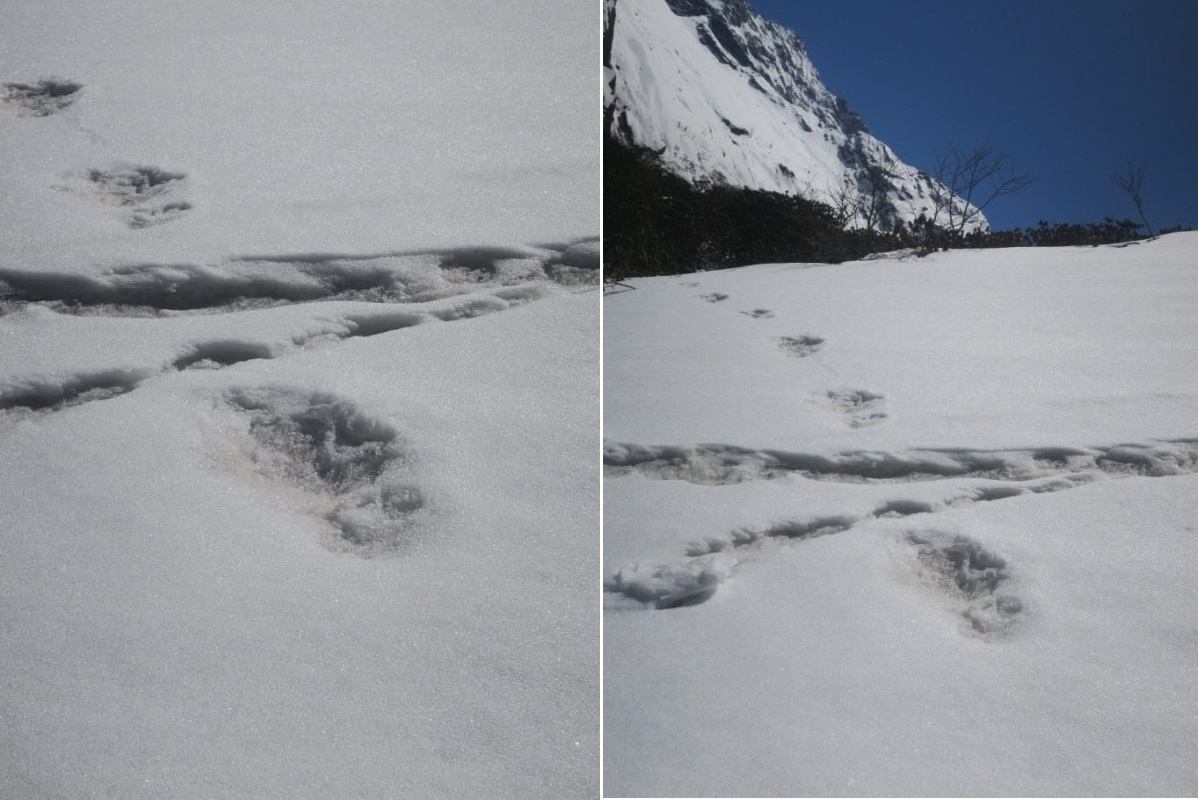Yeti myths, that is what the social media is busy with right now after the Indian Army claimed it had found footprints of the Abominable Snowman – a mythical creature which has since the start of the 20th century drawn generations of adventurers, explorers, scientists and storytellers to the Himalayas.
The Yeti is believed to be an elusive ape-like bipedal which roams some of the coldest and highest terrains in the Himalayas.
Advertisement
The Yeti has never actually been away from news for long, cropping up as ‘partial discoveries’ by enthusiastic trekkers and trackers.
But Monday, 29 April, was different. Some mountaineers had discovered footprints of the Yeti up in the Himalayas. Had it been any other mountaineers, people would have probably taken it with a pinch of salt but it was the Indian Army, and everyone takes them seriously.
“For the first time, an #IndianArmy Moutaineering Expedition Team has sited Mysterious Footprints of mythical beast ‘Yeti’ measuring 32×15 inches close to Makalu Base Camp on 09 April 2019. This elusive snowman has only been sighted at Makalu-Barun National Park in the past,” tweeted the Indian Army from its official Twitter account along with photos of what it claimed are the footprints of the mythical beast.
The Makalu-Barun National Park is in the north of Nepal close to the country’s border with China.
Read More: Indian Army finds ‘Yeti footprints’, tweets photographs
Even Chinese state-run media house People’s Daily took note of the tweet and asked its followers to comment on whether they believe that the Indian Army has indeed found tracks of a Yeti.
“Has evidence for the #Yeti finally been found? On Tuesday, the official Twitter account of the Indian Army posted photos of what they claim are footprints of the mythical beast. The post has gone viral, and many wonder if they are real. What do you think?” read a tweet posted by People’s Daily.
Yeti is one of the many mysterious creatures which have fuelled the imagination of countless people across countries and cultures.
A brief history of Yeti
James Prinsep’s Journal of the Asiatic Society of Bengal was the first to publish a first-hand account of a “sighting” in 1832. Naturalist B.H. Hodgson reported that his local guides in Nepal spotted a bipedal creature covered with dark hair fleeing in fear high up in the Himalayas. But Hodgson rejected it as an orangutan.
Hundreds of expeditions were carried out in the early part of the 20th century, with many claiming to have seen footprints or the Yeti itself.
Even Edmund Hillary and Tenzing Norgay reported seeing large footprints on their way to Mount Everest. (Hillary would later conduct an expedition in the search for Yeti.) But both Hillary and Norgay were sceptical of the existence of the beast of the Himalayas.
However, no one has ever been able to photograph a Yeti.
Yeti in popular culture
The mystery surrounding the mythical creature has resulted in a number of movies, TV shows, novels and comic books on Yeti. Among the films the 1964 Rudolph the Red-Nosed Reindeer was particularly noteworthy for it gave a cinematic look to the Yeti, which was adapted by other movies depicting the creature.
The 2008 film, The Mummy: Tomb of the Dragon Emperor, a principal Chinese character summons an army of Yetis to assist the heroes in their fight against the forces of the antagonist. The film depicts Yetis as huge ape-like creatures with King Kong-like strength and a high degree of ferociousness.
One of the recent movies to have dealt with Yeti as a subject was the Bengali film Yeti Obhijaan, which was based on a story by Sunil Gangopadhyay. The film, however, counters the myth around Yeti but leaves an ambiguous signal in the end.
Many, however, consider Tintin in Tibet, written in 1960, as the best story about Yeti. The comic book tale of a young Belgian journalist in an adventurous search for the Abominable Snowman has entertained – and continues to entertain – generations of readers.
Stories of the Yeti have also abounded Indian literary scene – most notably, Hindi comic books.
Jingalu, a recurring comic book character in Raj Comics, is a Yeti who becomes a lifelong friend of series hero Super Commando Dhruv after the latter saves the Yeti tribe from extinction at the hands of the “foreign enemy”.
Yeti in USA
The Bigfoot or Sasquatch is a mythical creature in American folklore whose description matches that of the Yeti. A key difference is while the Yeti is believed to live in the extremely frigid Himalayas, stories of Bigfoot place it somewhere in the moderate climate of Pacific Northwest. Like Yeti, no one has been able to find anything to conclusively prove that a Bigfoot exists. But like Yeti, the Bigfoot, too, has spawned everything from folk tales to merchandise.
Scientific explanations
The scientific community has neither convincingly rejected nor unanimously accepted the existence of Yeti. Yet one explanation that has been accepted by many is that the Yeti could be one of the many species of bears that can be found in the geographic region from where the most sightings have been reported.
Japanese researcher and mountaineer Dr Makoto Nebuka in 2003 said that his long linguistic study indicates that the “Yeti” is a corruption of the word “meti”, a regional Tibetan term for a “bear”, who the ethnic people both fear and revere.
An analysis of DNA extracted from hair and other samples believed to be of Yeti was done in 2017. The DNA matched with the DNA of various kinds of bears found in the region.
What people are saying about Indian Army discovering Yeti
While some raised questions on Indian Army’s ‘find’, others had a different view.
Whether or not the Indian Army actually found footprints of a Yeti, the legend of the Abominable Snowman may have just got its most powerful boost.











